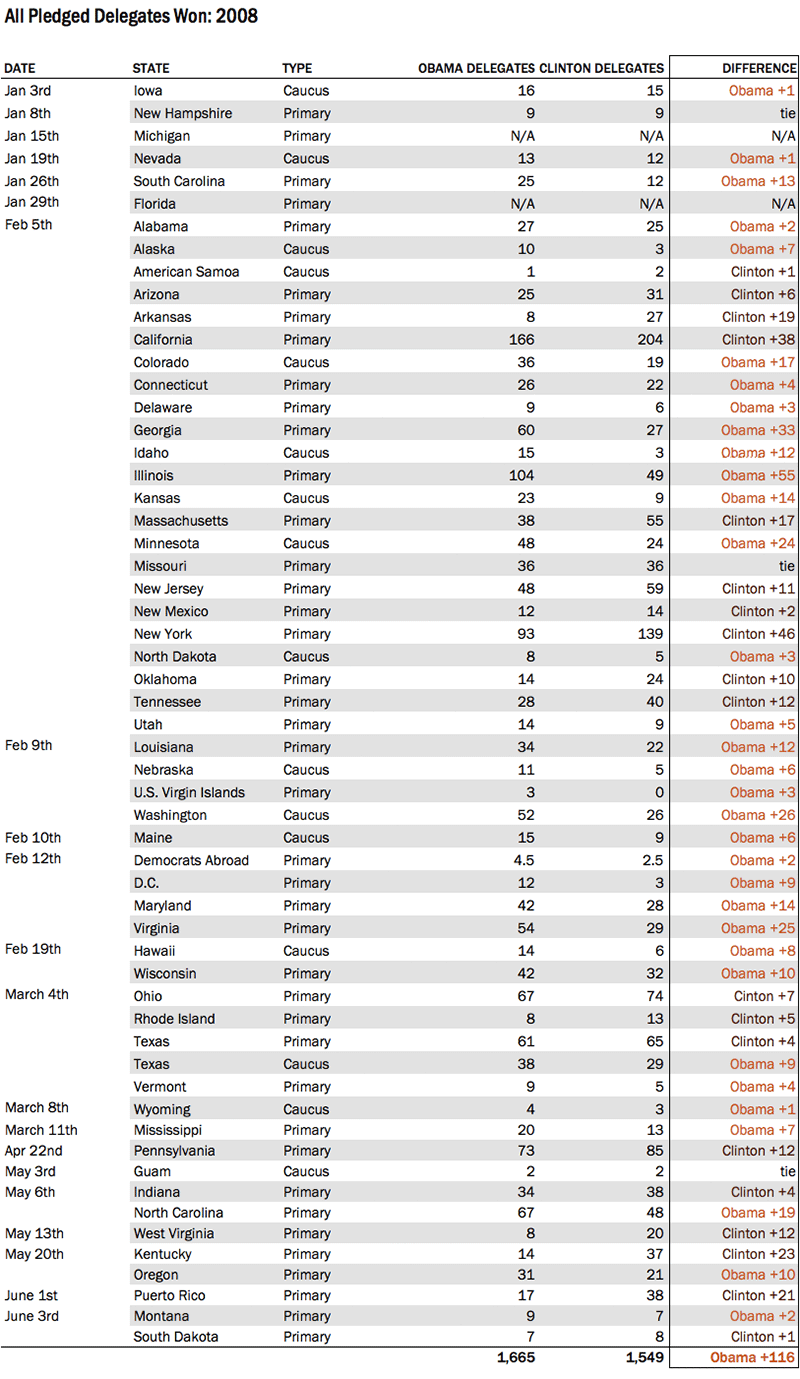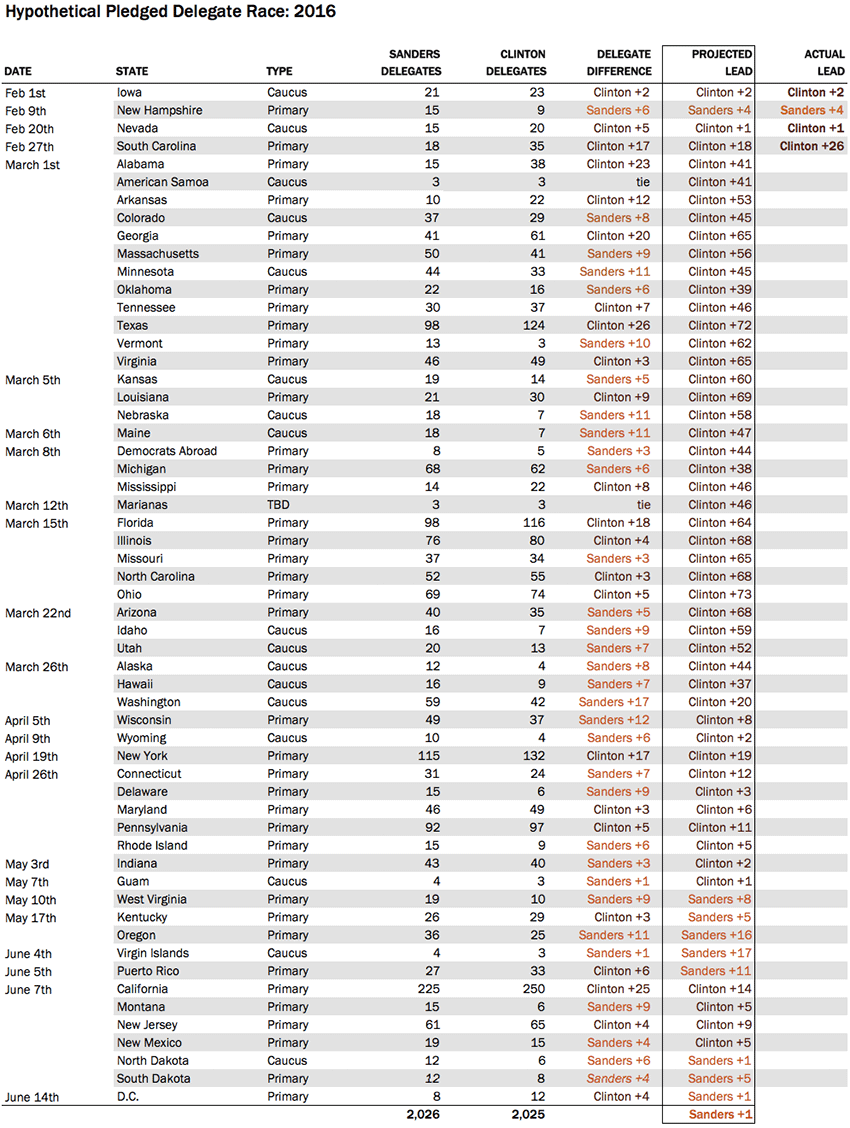Bernie Sanders Still Has a Path to Victory. Here It Is.
The media says Clinton is inevitable (again), but the battle for delegates could be closer than anyone expects
Christopher Hass

Note: This article has been updated to reflect the outcome of the South Carolina primary. You can read the second installment in this series here.
The main media narrative coming out of Saturday’s Nevada caucus was clear: Hillary Clinton’s got her inevitability back, and Bernie Sanders’ campaign is toast. You can see it across a broad swath of the political spectrum, from Salon (“Hillary Clinton’s Path Is Clear: Barring a catastrophe, her nomination is inevitable”) to the Drudge Report (“Bern Out: Hillary could end it all in two weeks!”).
But if you put aside conjecture and speculation for a moment, there’s really only one fact we can know for certain: Sanders trailed Clinton by just a single pledged delegate, 51-52, after Nevada. Yes, it’s true that, including superdelegates (which we’ll get to in a bit), a candidate needs to amass at least 2,383 total delegates in order to claim the Democratic nomination — but that’s just another way of saying that you have to win by one.
That’s not how the media tends to talk about the nomination, but it’s the framework to keep in mind as things unfold over the next few weeks and months — and it’s a framework the campaigns themselves clearly understand. For all the talk of momentum, it’s math that will determine the winner.
(Re)setting expectations
When polls closed in New Hampshire, two things happened within seconds: the networks declared Sanders the winner, and the Clinton campaign released a three-page memo that attempted to reframe not just her loss but the entirety of the race to come. The memo explained:
While important, the first four states represent just 4% of the delegates needed to secure the nomination. …
The way to win the nomination is to maximize the number of delegates we secure from each primary and caucus. That means, in many cases, that the margin of victory (or defeat) within a given state is actually more important than whether the state is won or lost.
Given its timing, the memo may have looked like sleight of hand to disguise an embarrassing loss, but the underlying point is absolutely correct. The early states, with their relatively small populations, account for only a fraction of the total primary votes. And though every delegate is a zero sum game (either Clinton wins it or Sanders does), every state is not. The margins matter.
So, let’s look at the margins.
What it takes
Trying to map the 2008 race to 2016 is an imperfect science, but 2008 does provide the most recent example of what a long, contested Democratic primary looks like (and of course, there’s one constant in both: Hillary Clinton).
Most everyone remembers the exciting first act of 2008: Barack Obama’s historic victory in the Iowa caucus, Clinton’s teary-eyed come-from-behind win in New Hampshire, and the photo-finish of the Nevada caucus. When seen in terms of delegate differential, however, it looks likes this:

The reality is considerably less dramatic, isn’t it? Math will do that. Now, here is where the race stands at the same point in 2016:

Next, let’s look at how the rest of the race unfolded in 2008, focusing on pledged delegates won by each candidate in each contest on the night of the election or caucus*, as well as the margin of delegate victory:

Note: The primary results in both Michigan and Florida were initially nullified because the states broke party rules by holding their elections too early in the year.
Three things stand out:
First, blow-outs are rare, but they can be devastating. Nearly half of Obama’s total delegate margin came from just one state: Illinois. Clinton had a chance to return the favor in New York, but despite the fact that her home state had many more delegates to award than Obama’s, her margin of victory was much narrower.
Second, a big win in a small state can be just as important as a small win in a big state. In 2008, the epic six-week battle for Pennsylvania (which saw the release of the Reverend Wright videos and Obama’s subsequent speech on race in Philadelphia) was one of the most intense and costly of the campaign. Yet, after more than 2.3 million votes were cast, Clinton’s margin of victory of +12 delegates was identical to what Obama gained in winning Idaho, a caucus of less than 22,000 people that flew completely under the radar.
Third, it’s hard to rack up big delegate wins, even with a clear majority of the vote. Each state has its own way of apportioning delegates, and whether you see it as a feature or a flaw, the system is designed in a way that provides even the loser with a large number of delegates. As an example, in New Hampshire earlier this month, if Clinton had just managed to break 45 percent the delegate split would have been 8-8: a draw.
Super freak
Before we go on, a word about superdelegates. In addition to the pledged delegates awarded in each state based on the voting, there are 712 unpledged delegates — so-called “super” delegates — who are free to vote for whomever they choose, whenever they choose — and they can change their minds whenever they like. These are Democratic Party leaders such as governors, members of Congress and party officials. They make up 15 percent of the total number of delegates, more than enough to upend the result in a close race. But that will never happen.
In 2008, there was a fair amount of handwringing over the possibility that superdelegates supporting Clinton would deny Barack Obama the nomination even if he won the most pledged delegates, and we’re seeing the same anxiety among Sanders’ supporters today. A number of progressive groups are already putting pressure on superdelegates to honor the results of the individual primaries and caucuses, and the superdelegate freak-out is likely only beginning.
But despite Clinton’s massive 452-to-19 lead among superdelegates who have endorsed so far, party officials simply aren’t going to overrule the will of Democratic voters. Doing so would damage the party and almost certainly doom the nominee. Imagine, say, Donald Trump being able to (accurately) claim that his general election opponent couldn’t even win over a majority of Democrats, and was only on the ballot because the establishment rigged the game. That’s not going to happen. This is going to be decided by voters.
What is disturbing, however, is that many mainstream outlets (including MSNBC and Politico) have begun combining superdelegate totals in with pledged delegates as part of their results on election night, and The New York Times, the Associated Press, Bloomberg news and others have begun including superdelegate endorsements in their overall delegate counts. Fairness and Accuracy in Reporting points out that this didn’t use to be the case, and doing so gives the false impression that superdelegates are somehow connected to the voting itself. They are not, and the media should stop pretending otherwise.
What happens next? ¯\_(ツ)_/¯
It’s difficult to go much further without making lots of assumptions about some 30 million people who have yet to vote, each and every one of whom will ultimately decide between Hillary Clinton or Bernie Sanders for reasons unique and knowable only to themselves.
But FiveThirtyEight’s Nate Silver recently took a close look at the two dozen or so states where Sanders seemingly has the best chance to do well, and Silver and others have begun to paint a more detailed, nuanced portrait of the emerging Sanders coalition and how it’s already making for a much different race than we saw in 2008. The one thing that hasn’t changed since 2008 is that the slow accumulation of delegates — not states — will be what determines the eventual winner.
Polling in upcoming states, to the extent that polling can even be trusted in the modern campaign era, is virtually nonexistent. Sanders won huge margins of young voters in both Iowa and New Hampshire, but we’ve yet to see if that will hold true with young voters of color. Clinton is winning the African-American vote, but it’s unclear yet if she’ll be able to continue doing so with the same overwhelming margin that Obama did in 2008. Sanders is reaching white voters that Obama lost to Clinton, and Clinton is winning over households with higher incomes that Obama won. Turnout so far has not been nearly as high as it was in 2008. There are a lot of unanswered (and unanswerable) questions.
But for the purpose of this thought experiment, let’s assume that a best-case scenario for Sanders would need to combine some or all of the following:
• Good performances in caucus states: Obama won 15 out of 16 caucuses in 2008, where turnout is lower and the activist base of the party has an outsized impact. The Clinton campaign knows this, and they’re focusing much more attention on the kind of organizing it takes to win these. That paid off in Nevada, but the caucus states could still provide Sanders (and his enthusiastic supporters) some of his best chances.
• Winning (enough) African American votes: Nationwide, Obama won the African-American vote 85 percent to 13 percent, and this translated into some of his biggest wins, including South Carolina, North Carolina and Georgia. This time, it’s Clinton who is winning the early support of African Americans. Sanders will have to narrow that gap enough to prevent big blowouts.
• Winning (enough) white working class voters in the South: Some of Obama’s biggest losses in 2008 were Kentucky, West Virginia and Tennessee — states with a large proportion of white, working-class Democrats. These may not seem like ideal states for a democratic socialist either, but there are signs that Sanders could conceivably be competitive—or even win—in places like this where Obama lost big.
• Winning large states with progressive voters: No matter how close Sanders keeps his losses, he’ll have to win somewhere. Three of Obama’s five biggest wins in terms of delegates were Washington, Virginia and Minnesota, and it is states like these — with relatively large populations of white, progressive voters — that may be Sanders’ best bet.
• Keeping it close: If Sanders does win, it’s likely to be much, much closer than Obama’s eventual 116-delegate margin. In 2008, many of Clinton’s top campaign advisors famously failed to plan for—or even understand—the actual mechanics of the nominating process. This time around, both campaigns have shown that they get how delegate math works and what it takes to win.
With all of this in mind, here’s a look at one hypothetical outcome where Sanders runs the table on all the factors above — and wins by one delegate:

This isn’t necessarily meant to be predictive — you could easily argue any (or all) of the individual outcomes above. There are plenty of scenarios where Clinton ultimately wins by even more than Obama’s 116 pledged-delegate margin from 2008, and she remains the clear favorite overall. But the point is this: As the election goes on, the math takes over — and the math is incremental, not momentous. The campaign will undoubtedly contain more big moments, but the victory will lie in the margins.
The last and perhaps most interesting thing illustrated by the scenario above is that Sanders will almost certainly have to come from behind to win, maybe more than once. The schedule for early March heavily favors Clinton. But from March 22 on, things look considerably more favorable for Sanders, and a string of primaries and caucuses could provide him with a chance to rack up a series of consecutive wins. If that happens, we could see an ever-tightening race to the finish. This is a long way from over.
* Every state has its own (often byzantine) rules for awarding delegates, and in some cases the pledged delegate count isn’t finalized for some time. The 2008 delegate tallies referenced here reflect, to the extent possible, the results from each election or caucus on the day it took place.
This is the first in an ongoing series on the delegate race for the Democratic nomination. Sign up here to make sure you don’t miss any upcoming installments.
Christopher Hass was Executive Publisher of In These Times from 2016 through 2021, and interim Publisher in 2022. Before joining ITT, he spent eight years working on political and advocacy campaigns, including both the 2008 and 2012 Barack Obama presidential campaigns. He is also the former editor and publisher of P8NT Magazine.







